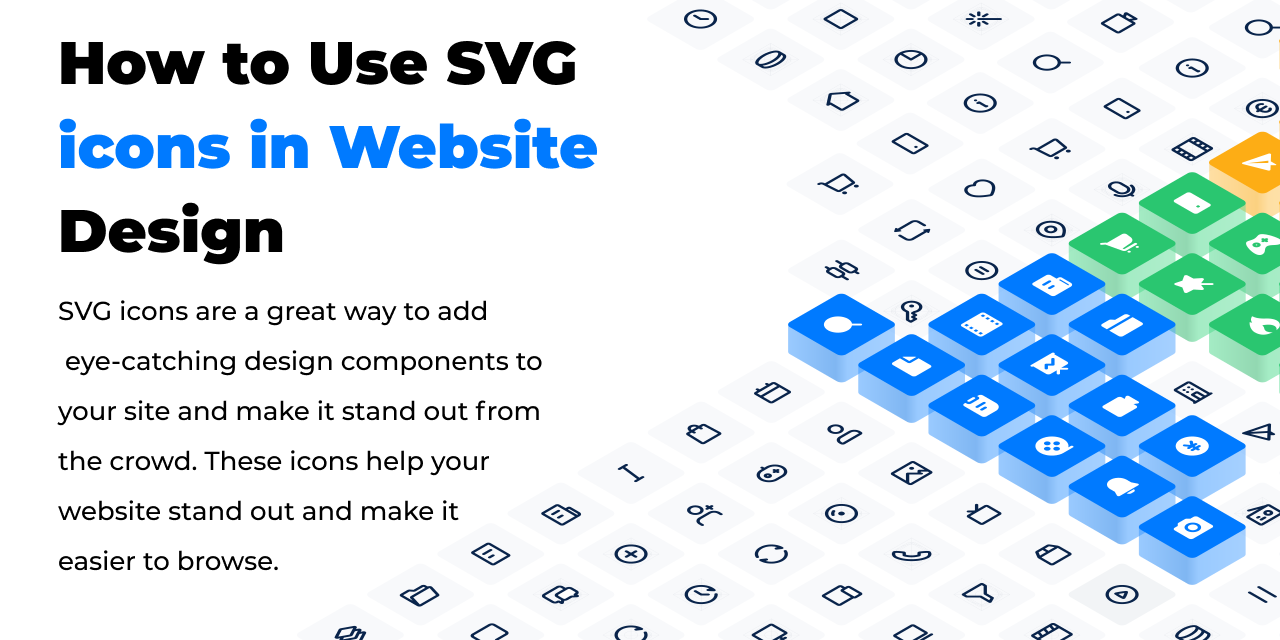How to Use SVG icons in Website Design

SVG icons are a great way to add eye-catching design components to your site and make it stand out from the crowd. These icons help your website stand out and make it easier to browse.
SVG icons are a terrific method to make your website’s content more engaging and dynamic. However, many designers still don’t know how to use them properly. SVG icons have become a go-to for website design, such as creating a landing page for your agency or business. But how do you style them? How do you make them look good within your design?
Let us take a ride to see how to use SVG icons in the website design. SVG is a way of producing vector graphics used on websites and across different devices. The idea is that an SVG file is created using several various tools, but the resulting image will always look the same.
Before starting, let’s talk about SVG:
Understanding SVG and SVG icons
Since SVG is the de facto standard for vector graphics, it is the first thing that comes to mind when someone wants to know how to create icons. SVG has been around since the early 1980s and is continually evolving. Some people use it for web graphics, while others use it for print materials. It’s useful for various purposes, from logos to ads to business cards to flyers.
It is similar to the way we draw images on the Web. It’s used to describe vector graphics, such as logos and icons, without having to make the actual graphics themselves. SVG allows us to create graphic elements that can scale up or down in size on the screen without being clipped by the browser.
Using SVG icons as a design element
SVG is an incredible deal for designing because it’s simple to use and requires no plugins. Simply, Drag and drop these icons into your document to place them exactly where you want them. SVG also lets you specify the sort of icon you want and its size and placement on the page. It also helps scale your icon easy, ensuring that it maintains the same quality when scaled down as when scaled high.
SVG icon in HTML:
SVG is what HTML is to text in terms of visuals. SVG graphics and their associated behaviours are described in XML text files, making them searchable, indexable, scriptable, and compressed. It also means that they may be generated and updated in any text editor or art program.
SVG graphics are supported by the HTML <svg> element. SVG graphics feature a container used to draw various forms, such as boxes, pathways, text, graphic images, and circles. This HTML tag is backed up by almost every modern browser.
SVG icon in CSS:
SVG is a lightweight vector image format that supports interactivity and animation and is used to show a range of visuals on the Web and in other settings.
An SVG is simple to inline in CSS code as a backdrop image. It is helpful for more minor, reusable icons because it eliminates the need for additional HTTP queries.
Best Practices for creating SVG Icons
SVG icons are a modern and stylish method to give your creations more visual appeal. They differ from other image formats such as JPG and PNG, and their resolution is higher than that of different sorts of icons. These icons are scalable, which means you can make them any size you want without compromising quality. SVG icons are utilized for practically any design requirement, from logos to website template designs.
While creating the Free SVG Icons, a few things are to be kept in mind for the perfect outcome.
- Grid for icon:
While creating Free Vector Icons, a grid on which whole project icons are based needs to be developed. It ensures that icon sets and other factors in the application are uniforms. Remember to remove the grids before exporting the SVG to get a smooth icon. - Name the icon:Naming the icons’ layers will help create a different ID for the container. The classes can be the same while creating other icons of the same categories. For example, some of the attributes of animal icons are similar, like legs, eyes, ears etc. So to create them, the classes are identical. Naming the layers of these classes for each of the icons will reduce the confusion and simplify the work.
- Use of gradients:
Do SVGs need to be monochrome? Not really; gradients can also be used to enhance them. You can achieve this while keeping your SVG file size modest and efficiently controlling colours with your stylesheet.
Also Read: www osmose technology login
Using SVG icons to create a website
SVG icons are an excellent method to include dynamic content on your website. Many designers and developers have been utilizing SVG icons for years, but most of us are only familiar with the basics.
Using SVG icons in your web design can help your site appear more professional and polished. Most websites utilize a standard icon set, with which you’re certainly acquainted. It has eight fundamental file kinds, such as text (text/html), image (jpg/png), audio (mp3/wav), video (mp4/webm), and so on. To create a dynamic page-to-page layout, icons can be put inside and outside the content.
Conclusion
Many designers still don’t know how to use them properly. Let us take a ride to see how we use the de facto standard for vector graphics, the SVG icon. SVG is what HTML is to text in terms of visuals. It’s used to describe vector graphics, such as logos and icons, without having to make the actual graphics themselves. It also lets us create graphic elements that can scale up or down in size on the screen.
SVG icons are a modern and stylish way to give your creations more visual appeal. They differ from other image formats such as JPG and PNG, and their resolution is higher than that of different sorts of icons. These icons are scalable, which means you can make them any size you want without compromising quality. SVG icons are an excellent way to include dynamic content on your website. Naming the icons’ layers will help create a different ID for the container. Most websites utilize a standard icon set with which you’re indeed acquainted.
Also Read: pizza box computer




